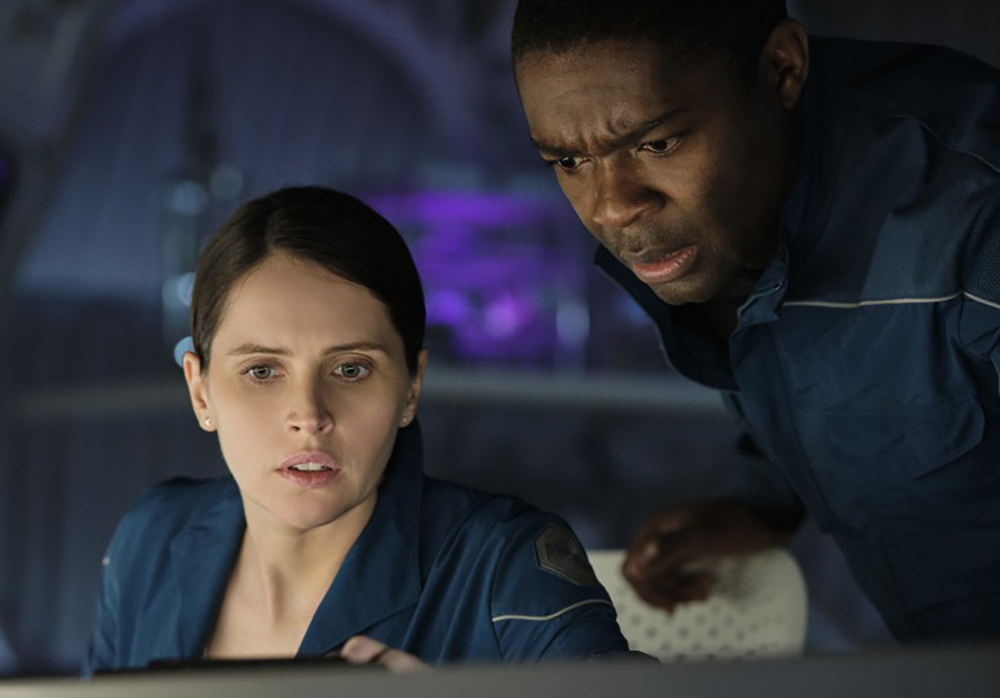George Clooney’s highly anticipated new Netflix film, “The Midnight Sky,” is a curious offering. His influence from working with visionary directors on projects like “Gravity” with Alfonso Cuarón has inspired his latest directorial duties, with sublime imagery capturing the vast, frozen panes across the arctic and the isolation in deep space.
What seems to be missing is the connection between the dueling storylines, with action sequences spliced into the meandering plot. Produced by Clooney’s Smokehouse Pictures, “The Midnight Sky” follows a terminally ill scientist who is desperately trying to inform a small crew aboard a spacecraft of the catastrophe that has befallen Earth when he finds a young girl left behind at the observatory he is occupying. What might’ve been an engaging tale of survival is instead a mix of two storylines: one in space and one on Earth, that seldom connect as the stakes remain unclear.
Set in 2049, Clooney plays Dr. Augustine Lofthouse. After finding out he is terminally ill, he decides not to vacate the Barbeau Observatory in the Arctic Circle and instead stays to continue his work. Trains of residents march toward helicopters as Dr. Lofthouse saunters back inside to administer his own blood transfusion. To occupy his time, he sleeps, paces the hallways, plays chess alone, and drinks copious amounts of whiskey. One evening he peers on a computer screen at a map of the United States as red dots expand to cover the country. His eyes go wide, and we understand there has been an insurmountable catastrophe.

Dr. Lofthouse becomes aware that a single mission remains in space, the Aether, which includes five crew members. For their part, the space crew, including the pregnant mission specialist Sully (Felicity Jones), Captain Ade (David Oyelowo), pilot Mitchell (Kyle Chandler), Sanchez (Demián Bichir), and young Maya (Tiffany Boone), are unaware of what’s happened on Earth. Sully struggles to connect with NASA or any living being on Earth, and the crew begins to worry that they will be stranded. Meanwhile, Lofthouse discovers a young girl left behind during the evacuation, Iris (Caoilinn Springall). She doesn’t speak but seeks comfort in being found by Dr. Lofthouse, and he gradually warms to her presence as he endeavors to communicate with the spacecraft.
“The Midnight Sky” is based on Lily Brooks-Dalton’s book and has been adapted to the screen by Mark L. Smith, who focuses on Dr. Lofthouse for much of the first half. While his terminal illness feels immediate, his journey through the Arctic with Iris to find an antenna at an accompanying facility only serves to add action sequences, which do little to move the plot forward. The flashback sequences featuring a young Dr. Lofthouse (played by Ethan Peck) also hinder the story’s momentum. The intentions to show his most meaningful relationship, one that fills him with regret at the end of his days, struggles to provide much context for present-day Dr. Lofthouse. Alexandre Desplat’s score tries to develop pacing, but the film remains at a slow stroll without a strong foundation.
The balance between the two stories is muddled because it is unclear whether the space crew’s threat is returning to Earth or not returning at all. Fortunately, we’re provided with affecting scenes like when Kyle Chandler’s Mitchell sits alone eating breakfast as holograms of his family speak and laugh around him. The visualization is sincere and affecting. Indeed, the more exciting story seems to be with the space crew, though the relationships seem superficial with expositional dialogue used to establish the connections. Ade is the father of Sully’s baby, and during a chess match early in the film, he tells Sully that he is a child prodigy. But she acknowledges that she knows, having looked at his file, and her response feels introductory rather than lived in.
Of course, there are concerns with the crew’s safety. Their issues are present and frightening. But the film struggles to establish why what’s happening to the crew is as challenging, giving the suspense a hollow impression. If anything, the structural decision to heighten Dr. Lofthouse’s journey challenges the efficacy of the crew’s condition. The narratives don’t work alongside each other, but individually, they are more compelling.
While the story with the space crew doesn’t find its footing, Cinematographer Martin Ruhe and Production Designer Jim Bissell have created stunning imagery to accompany these scenes, which becomes incredibly valuable when the team must repair the ship from the outside. A disaster midway through the film sends Augustine into the icy Arctic waters, and while the scene feels unrealistic, the imagery is captivating. Clooney is at his morose best as the bearded Dr. Lofthouse, and he does fine work illustrating the burden he carries as being one of the last remaining survivors in the world. The spacecraft crew has less to do, but Tiffany Boone stands out as a wide-eyed, young crew member who hates being outside the vessel.
Overall, this is a confident space film that cements Clooney as a capable filmmaker, but the script needed more of a pulse.
1 Comment
Informative & nicely balanced review Matthew Koss, I enjoyed your critique.